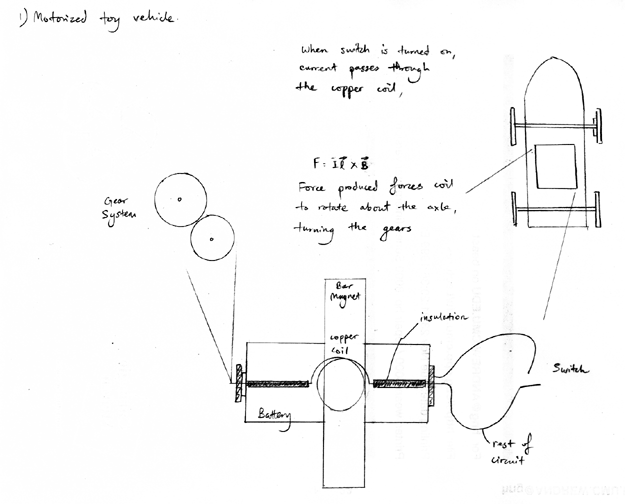

Physical principle:
|
Description
|
Symbol
|
| Force induced by interaction between current and magnetic field |
F
|
| Magnetic field strength, expressed as a vector |
B
|
| Current through copper coil |
I
|
| Length of wire through which magnetic field passes, expressed as a vector |
L
|
When switch is turned on, current passes through the coil, interacting with the magnetic field produced by the magnet. By electromagnetic induction, a force, F, is induced. This can be represented by the equation:
F = I*L X B (X is the vector cross-product).
The direction of F can be deduced using the right-hand rule.
Due to the current flowing in opposite directions along different lengths of
the coil, the force induced for each of these lengths will be in opposite directions,
thus making the coil rotate about the y-axis.
This rotation can then be channeled to a gear system to drive wheel axles or
propellers for toy vehicles.
How to play:
When the motor is switched on, the toy vehicle starts to move forward.
The toy will have a transparent casing, revealing to the child the entire motor
and how the motion is generated. Multiple vehicles can be operated at one time
in races or placed on tracks of various configurations.
Technical information:
- Cost:
Initial estimate is $15, for the entire contraption. although the materials
that constitute the motor can be obtained cheaply, it is the exterior design
and subsequent manufacture of the toy vehicle that will be the toy's selling
point. Hence for marketing purposes, the aesthetics will count for most of the
cost.
- Durability:
The common plastics used for toy cars are the main materials used,
apart from copper wire, magnet, and battery. If the toy is dropped frequently,
the strength of the magnet will decrease and the motor's output will weaken.
Light plastics should be used so that the vehicle can be easily propelled.
- Safety:
Emphasis on rounded edges and electrical insulation is the main priority. The
battery casing must be effectively insulated and the toy should not be easily
disassembled so that the child does not come in contact with any of the other
electrical components.